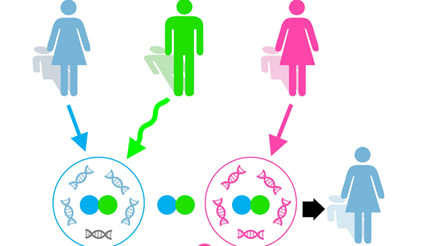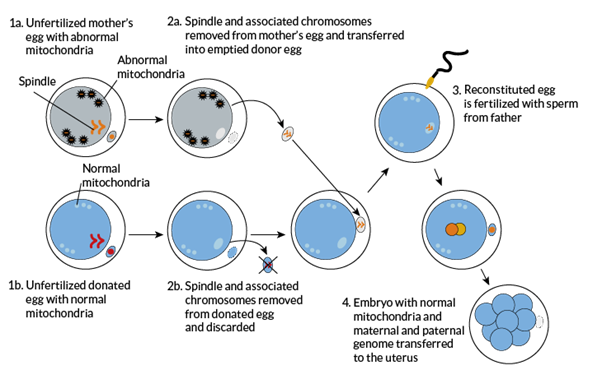The concept of “three-parent babies” refers to a revolutionary reproductive technology that allows for the creation of human offspring using genetic material from three individuals: one man and two women. This technique primarily aims to prevent the transmission of mitochondrial diseases, which are inherited through maternal mitochondrial DNA (mtDNA). This article explores the science behind three-parent babies, the techniques used to create them, notable examples, and the ethical considerations surrounding this technology.

The Science Behind Three-Parent Babies
Mitochondrial DNA and Its Importance
Mitochondria are often referred to as the “powerhouses” of cells, as they generate energy in the form of adenosine triphosphate (ATP). Unlike nuclear DNA, which is inherited from both parents, mtDNA is exclusively passed down from mothers to their children. This means that any mutations present in a mother’s mitochondria can be transmitted to her offspring, potentially leading to severe mitochondrial diseases. These diseases can affect various systems in the body, including muscular, neurological, and metabolic functions.
Mitochondrial Replacement Therapy (MRT)
To prevent the transmission of mitochondrial diseases, scientists developed Mitochondrial Replacement Therapy (MRT), which involves replacing defective mitochondria in a mother’s egg with healthy mitochondria from a donor. There are two primary techniques used in MRT:

1. Pronuclear Transfer: In this method, both the mother’s egg and a donor egg are fertilized with sperm from the father. The nuclei from both fertilized eggs are then removed. The nucleus from the mother’s fertilized egg, which contains her genetic material but also defective mitochondria, is transferred into the donor egg that has healthy mitochondria but whose nucleus has been discarded. The resulting embryo contains nuclear DNA from both parents and healthy mitochondrial DNA from the donor.
2. Maternal Spindle Transfer: This technique involves removing the spindle apparatus (which contains the mother’s nuclear DNA) from her egg before fertilization and transferring it into a donor egg that has had its nucleus removed. The donor egg then contains healthy mitochondria along with the mother’s nuclear DNA when fertilized by sperm.
Examples of Three-Parent Babies
1. The First Three-Parent Baby: In 2016, a baby boy was born to Jordanian parents using MRT techniques developed by Dr. John Zhang at New Hope Fertility Center in New York City. The mother carried genes for Leigh syndrome, a severe neurological disorder caused by mitochondrial mutations that had previously led to the deaths of her first two children. The procedure was performed in Mexico due to regulatory restrictions in the U.S., and it successfully resulted in a healthy baby who shows no signs of disease.
2. Subsequent Births: Following this groundbreaking birth, reports emerged of additional babies born using similar techniques in other countries. For instance, medical scientists in Ukraine reported births resulting from MRT applications aimed at treating infertility and preventing genetic diseases.
3. UK Clinical Trials: In 2017, clinical trials began at Newcastle Fertility Centre in the UK after legislation was passed allowing MRT for preventing mitochondrial diseases. Although specific births resulting from these trials have not been widely publicized yet, they represent an important step toward regulated applications of this technology.
Ethical Considerations and Safety Concerns
The introduction of three-parent babies raises numerous ethical questions and safety concerns:
1. Ethical Dilemmas: Critics argue that manipulating human embryos raises moral questions about “playing God” and could lead to unintended consequences in future generations. There are concerns about consent from donors and potential psychological impacts on children born through these methods.
2. Health Risks: Long-term health effects of MRT on children born through these techniques remain largely unknown. While initial results may be promising, there is concern about potential complications arising from having genetic material from three different individuals.
3. Regulatory Challenges: Different countries have varying regulations regarding MRT and genetic manipulation technologies. In some places, such as the United States, strict regulations limit research and application of these techniques, while others like the UK have embraced them under controlled conditions.
4. Designer Babies: There is apprehension that advancements in genetic manipulation could lead to “designer babies,” where parents might select traits or characteristics beyond health considerations.
Conclusion
Three-parent babies represent a significant advancement in reproductive technology aimed at preventing mitochondrial diseases while enabling families affected by these conditions to have healthy children. Through techniques like Mitochondrial Replacement Therapy (MRT), scientists are exploring new frontiers in genetics that hold promise for treating hereditary diseases.
However, as with any groundbreaking technology, ethical considerations and safety concerns must be carefully addressed through rigorous scientific research and regulatory oversight. Ongoing studies will help determine long-term outcomes for children born via these methods while ensuring that this technology is used responsibly and ethically.
As our understanding of genetics continues to evolve alongside technological advancements, three-parent babies may pave the way for new possibilities in reproductive health and disease prevention—offering hope to families affected by devastating genetic disorders while challenging us to consider the moral implications of such innovations.
Spread the Word

